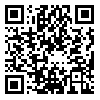Recently, attentions have been taken on the investigations regarding the use of nano-sized compounds in different fields including agricultural sector. Due to the importance of evaluating the fate and operation of nano-particles in plant systems, in this survey, responses of 13 wheat genotypes to the effect of nano-iron chelate fertilizer in the Hoagland solution under the conditions of ordinary iron chelate and nano-iron chelate, with concentration of 22.5 mg/L, was studied. This experiment was carried out in Research Greenhouse of Soilless Culture Research Center, Isfahan University of Technology, Iran, in the spring of 2013. Results showed that there were considerable positive and negative variations among wheat genotypes in response to application of nano-sized iron chelate fertilizer. Under the application of iron chelate, among the different measured traits, number of tillers and root/shoot ratio had the highest coefficient of variations, and the lowest values were observed for chlorophyll flourescence and green leaf surface. Under the application of nano-iron chelate, number of tillers and root/shoot ratio had the highest coefficient of variations, and the lowest value was observed for chlorophyll flourescence content. Nano-iron chelate fertilizer caused reduction of average dry matter yield of shoots, leaf area and root volume by 14.1, 9.5 and 8.9 percent, respectively, and increased root/shoot ratio by 13.7% for some wheat varieties, in comparison with the ordinary iron chelate. In response to nano-iron chelate fertilizer, compared to ordinary iron chelate, Line-9-shoory produced the highest total dry matter (14.49% increase) and Star variety had the lowest total dry matter (-51.82%).
Received: 2015/11/4 | Accepted: 2015/11/4 | Published: 2015/11/4
| Rights and permissions | |
 |
This work is licensed under a Creative Commons Attribution-NonCommercial 4.0 International License. |







